Archive for March, 2017
$20K Small Business Tax Break End In Sight
Can you believe it’s been two years since the government announced the ‘Instant Asset Write-off” incentive in 2015?

To recap, the incentive runs as follows:
Any small business (turnover <$2m) buying an asset under $20,000, is eligible to write off 100% of the value immediately rather than claim depreciation over the following years. This was (and still is) an unprecedented scheme in terms of its generosity for small business (the previous instant asset write off threshold was just $1,000) and $1.75 billion was set aside in the 2015 budget to cover the incentive.
More Info: http://www.abc.net.au/news/2015-05-13/budget-2015-small-business-tax-break-explained/6466066
However, all good things come to an end and this 2-year incentive we be no longer from 30th June 2017.
What this means is that, if you are a small business, and there’s any sort of asset purchase you’re considering under this threshold, then act NOW to save yourself literally thousands of dollars compared to a post 30 June purchase.
Naturally, our interest and expertise is in cars and these days there are hundreds of models of vehicles that fit under this threshold. We would love to help any reader with such a purchase but above all, whether you buy through Private Fleet or directly from a dealer, we urge you to act now! Do not leave it too late. The purchase must be finalised before 30th June (paid for and delivered) and, with long waiting times for many models, it would be easier than you think to miss out.
I remember several years ago when another related incentive was offered and the dozens of disappointed potential buyers we spoke to who had left their run too late. Order today for delivery mid June, if you like but get your name on the list! Good luck!
2017 Toyota Camry Altise: A Private Car Review.
Toyota Australia confirmed recently that the Aurion nameplate will be dropped and replaced by a Back to the Future nameplate. Camry V6, anyone? However, surrounded by a fleet of SUVs and the evergreen Corolla, what’s left in the tank for the base model nameplate, Altise? Private Fleet drives the 2017 Toyota Camry Altise and comes away wondering if it’s time to put this one out to pasture? When Camry first landed on Australian soil, it was a simple five door hatch. That morphed into a sedan and wagon range which, eventually, became a sedan only and gave birth to a renamed V6 version plus sheetmetal changes. That car was called Aurion and graced showrooms for barely a decade. Now Toyota has canned that car, the Camry is left as a large car in a medium car market thanks to its four cylinder powerplant.
When Camry first landed on Australian soil, it was a simple five door hatch. That morphed into a sedan and wagon range which, eventually, became a sedan only and gave birth to a renamed V6 version plus sheetmetal changes. That car was called Aurion and graced showrooms for barely a decade. Now Toyota has canned that car, the Camry is left as a large car in a medium car market thanks to its four cylinder powerplant.  A 2.5L capacity unit, in base trim it spins out just 133 kilowatts at 6000 rpm and a reasonable but not overwhelming 231 Nm of torque at 4100 rpm. With a dry weight of 1465 kg to pull around plus 70 litres of 91 RON and human cargo, it’s no surprise that Toyota says it’s a 11.1L/100 kilometre consumption figure for its natural environment, the urban jungle. There is a Hybrid system available which, along with the four and V6, will carry over to the imported 2018 spec model.
A 2.5L capacity unit, in base trim it spins out just 133 kilowatts at 6000 rpm and a reasonable but not overwhelming 231 Nm of torque at 4100 rpm. With a dry weight of 1465 kg to pull around plus 70 litres of 91 RON and human cargo, it’s no surprise that Toyota says it’s a 11.1L/100 kilometre consumption figure for its natural environment, the urban jungle. There is a Hybrid system available which, along with the four and V6, will carry over to the imported 2018 spec model. The Camry IS a big car. At 4850 mm long, 1470 mm high and 1835 mm wide, it well and truly takes it up to its classmates in the form of Falcon, Commodore, Sonata, Optima et al, and it really is only the engine that makes it a medium sized car in classification. It’s a proper five seater, rolls on a 2775 mm wheelbase, and has a boot big enough to swallow a couple of golf club carriers with room to spare, at 515L.
The Camry IS a big car. At 4850 mm long, 1470 mm high and 1835 mm wide, it well and truly takes it up to its classmates in the form of Falcon, Commodore, Sonata, Optima et al, and it really is only the engine that makes it a medium sized car in classification. It’s a proper five seater, rolls on a 2775 mm wheelbase, and has a boot big enough to swallow a couple of golf club carriers with room to spare, at 515L.  Inside, there’s two bottle and cup holders up front for driver and passenger, with the rear getting two cup holders and four bottle holders. There’s also Bluetooth audio, standard AM/FM radio and CD (couldn’t find a USB/3.5 mm plug setup though) however the review car was also fitted with DAB. And yes, even the average speakers on board still sounded good for DAB.
Inside, there’s two bottle and cup holders up front for driver and passenger, with the rear getting two cup holders and four bottle holders. There’s also Bluetooth audio, standard AM/FM radio and CD (couldn’t find a USB/3.5 mm plug setup though) however the review car was also fitted with DAB. And yes, even the average speakers on board still sounded good for DAB. Interior trim was basic: black cloth, black plastic, manual adjustment for the seats, driver’s window only was one touch Up/Down, a binnacle centre speedo flanked by a tacho and combined fuel level and dial (not digitally) based consumption display. It’s old school in layout for the console, with dials for the aircon temperature and speed but a touch more modern for direction thanks to individual tabs. It’s typical Toyota in that the ergonomics are spot on however it’s a lacklustre look, with no real visual appeal in deference to basic functionality. If there’s a win here, it’s that it looks better than, even though there’s hints of, the dash from the IS series. Another score is the amount of hip/shoulder/leg room on offer.
Interior trim was basic: black cloth, black plastic, manual adjustment for the seats, driver’s window only was one touch Up/Down, a binnacle centre speedo flanked by a tacho and combined fuel level and dial (not digitally) based consumption display. It’s old school in layout for the console, with dials for the aircon temperature and speed but a touch more modern for direction thanks to individual tabs. It’s typical Toyota in that the ergonomics are spot on however it’s a lacklustre look, with no real visual appeal in deference to basic functionality. If there’s a win here, it’s that it looks better than, even though there’s hints of, the dash from the IS series. Another score is the amount of hip/shoulder/leg room on offer.
 Outside, the Altise differs slightly from its stablemates, the Hybrid, Atara, and RZ, in having globe lit driving lights, not LED, in the left and extremities of the front bumper, plus the spindle design element is not as pronounced. Compared to the superceded model it looks longer, sleeker, wider, especially at the rear with the broadened tail lights, and more purposeful there, however the front has five horizontal bars that lend an almost baleen whale look to the snout. There’s even a change to the C pillar that lengthens the windowline and there’s plenty of glass to give passengers a broad and airy feeling.
Outside, the Altise differs slightly from its stablemates, the Hybrid, Atara, and RZ, in having globe lit driving lights, not LED, in the left and extremities of the front bumper, plus the spindle design element is not as pronounced. Compared to the superceded model it looks longer, sleeker, wider, especially at the rear with the broadened tail lights, and more purposeful there, however the front has five horizontal bars that lend an almost baleen whale look to the snout. There’s even a change to the C pillar that lengthens the windowline and there’s plenty of glass to give passengers a broad and airy feeling. That 2.5L four and not inconsiderable heft make the Camry a willing if not spirited performer on road. Acceleration is leisurely at best, accompanied by a soundtrack that never gets raucous yet indicates a struggle to really pull. The six speed transmission is smooth enough however had the disconcerting tendency to brake the engine under almost any forms of acceleration. Light throttle, move, gear change, brake, accelerate again…repeated through to medium and most heavy throttle applications. In fact, the only time the car felt as if it had any life was in a hard acceleration from a blind corner, which momentarily had the front driven 215/60/16 tyres from Michelin chirping.
That 2.5L four and not inconsiderable heft make the Camry a willing if not spirited performer on road. Acceleration is leisurely at best, accompanied by a soundtrack that never gets raucous yet indicates a struggle to really pull. The six speed transmission is smooth enough however had the disconcerting tendency to brake the engine under almost any forms of acceleration. Light throttle, move, gear change, brake, accelerate again…repeated through to medium and most heavy throttle applications. In fact, the only time the car felt as if it had any life was in a hard acceleration from a blind corner, which momentarily had the front driven 215/60/16 tyres from Michelin chirping. Coupled with a not quite en pointe’ steering set up (vague, somewhat disconnected), a suspension set up that has mild tautness up front but with short travel struts that feel as if they’ll rip out over bigger speedhumps, as opposed to a softly sprung rear end that bottoms out just a bit too easily, it’s a dynamics package that’s a bit like burnt porridge for the three bears. Not too hot, not too cold, but no longer just right.
Coupled with a not quite en pointe’ steering set up (vague, somewhat disconnected), a suspension set up that has mild tautness up front but with short travel struts that feel as if they’ll rip out over bigger speedhumps, as opposed to a softly sprung rear end that bottoms out just a bit too easily, it’s a dynamics package that’s a bit like burnt porridge for the three bears. Not too hot, not too cold, but no longer just right.
At the time of writing, the Camry Altise petrol had a driveaway price of just of $30K, but was also being offered with a special driveaway price of (from) $27990 with free satnav. There’s also the standard three year warranty or 100,000 kilometre covered, plus up to five low cost, capped price, standard logbook services at $140 for the first 4 years or 75,000km, whichever occurs first. Naturally there’s a full suite of safety systems including seven airbags,
At The End Of The Drive.
It’s been said of certain kinds of cars that they’re whitegoods on wheels. They’re designed to do a job, without any real appeal but also to do it without any hint of failure. Being the entry level member to the Camry family, that role falls to the Camry Altise. It has looks that are inoffensive without being overtly visually appealing, it has a drivetrain that does a job without being exciting nor overly dull. There’s an interior that mixes a bit of modern tech with more than a nod towards history.
Harsh it may be, but the 2017 Toyota Camry Altise is the four wheeled embodiment of a whitegood on wheels. As such, it’s this level of spec that may continue to sell to fleet buyers that require naught more than the appliance to get them from A to B to A again. With the 2018 range, to be imported from Japan, yet to be fully confirmed, the question of whether to retire (in this writer’s opinion) the Altise won’t be answered but given it’s a cost effective entry level member, it’s unlikely to be shuffled into retirement.
Head to 2017 Toyota Australia range for info on all Toyota products including the Camry.
Cop Cars Around The Globe
 A couple of days ago, the Dubai police force created a bit of a stir in the automotive world by managing to scoop the Guinness World Record for the fastest police car on the roads: a Bugatti Veyron. With a top speed of 407 km/h and a 0–100 time of 2.5 seconds. The acquisition and fitting of the Veyron as a police car is something of a PR exercise for the Dubai Police; however, it joins some of the other supercars driven by the police in this country, making the United Arab Emirates possibly the country where it’s most fun to be a cop. Others in the Dubai police fleet include a Aston Martin One-77, a Lamborghini Aventador LP 700-4, a Ferrari FF and the “humbler”(?) Audi R8 , Nissan GTR and Mercedes SL 63.
A couple of days ago, the Dubai police force created a bit of a stir in the automotive world by managing to scoop the Guinness World Record for the fastest police car on the roads: a Bugatti Veyron. With a top speed of 407 km/h and a 0–100 time of 2.5 seconds. The acquisition and fitting of the Veyron as a police car is something of a PR exercise for the Dubai Police; however, it joins some of the other supercars driven by the police in this country, making the United Arab Emirates possibly the country where it’s most fun to be a cop. Others in the Dubai police fleet include a Aston Martin One-77, a Lamborghini Aventador LP 700-4, a Ferrari FF and the “humbler”(?) Audi R8 , Nissan GTR and Mercedes SL 63.
Not many of the boys and girls in blue around the world are so lucky. Most of them have to put up with much more mundane machines, albeit with all the extras that cops get to play with, including the lights and sirens.
Australia:
The Ford/Holden rivalry extends to the police fleet, with Ford Falcons and Holden Commodores making up the bulk of the fleet in various incarnations for the past 30 years or so. Now, however, with the demise of Ford and Holden in Australia, taking these iconic marques with them, the cops are looking for new wheels that can do the business of high-speed chases. The Kia Sorento SUV is one contender, along with the Ford Mustang, Chrysler 300 and BMW 5-series. The new Kia Stinger is also a contender – or at least it will be when it goes on sale in Australia. Watch this space!
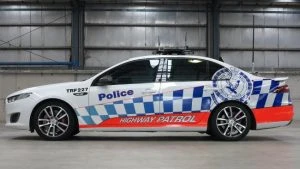 United Kingdom:
United Kingdom:
In spite of the original Top Gear Unholy Trinity sneering that the British police got about mostly in Vauxhall Astras, the modern equivalents of Robert Peel’s special troops get around in a selection of BMWs, mostly 3 and 5 series, plus a few others, including the quirky Renault Twizy (probably as a PR exercise, as this is going to be useless in a high speed chase)
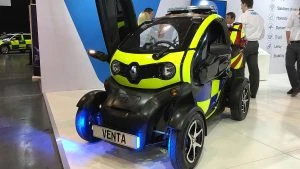
Germany:
What do you think they use as police cars in Germany? Plenty of BMWs (320 Dt being popular), Audi A4s and a smattering of other local marques, including Opels and Volkswagens.
USA:
The most common are the Ford Crown Victoria and the Chevrolet Impala. However, Ford USA also puts out some cop cars that come off the factory floor ready to go on duty, the Ford Police Interceptor Utility being one of them.
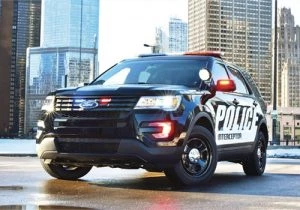
France:
The latest addition to the fleet of the gendarmerie is the Renault Megane Coupé RS . Keeping it local and classy!
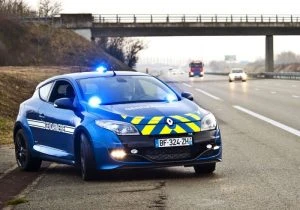
India:
India also believes in keeping things local, which means you’re not going to pick up the equivalent in your local Aussie car yards if you have a hankering to drive what the cops in India drive. At any rate, you’ll have a hard time finding the Mahindra Scorpio and an even harder one finding the Mahindra Marksman (which comes complete with machine gun mounts).
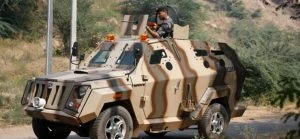
Israel:
Without the need to keep things local and with a need for serious security, the Israeli police – which is considered to be a division of the military Special Forces – need something pretty rugged. Toyota Landcruisers, Isuzu Troopers and Land Rover Defenders all get used, as do Hummers. In urban areas, a selection of sedans get used, with Toyotas being spotted frequently.
Russia:
Wikipedia lists a host of Ladas as being the patrol car of choice for the Russian police. However, before you decide that this is the best place to try a heist, think again. The fleet has recently been updated with a collection of Audi R8 V8s.
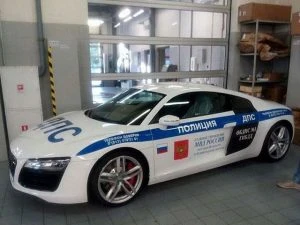
Finland:
In a land where rally driving is one of the top sports and getting a license means some really intensive training including ice driving, what do the cops use? The English version of the official Finnish police site is coy about the marques used but prodding elsewhere suggests that alongside vans of various types, the Mercedes Shooting Brake is part of the fleet. See how you go with one official video – even if you speak no Suomi, you can pick out the words for “police” and “Mercedes Shooting Brake” easily enough.
Incidentally, for those who prefer a second-hand car to a new one, I’ve heard it said that getting an ex-cop car can be a good pick. They have high mileages but have been superbly maintained with speed camera fines taxpayer dollars. All the extra bells and whistles, beginning with the lights and sirens, are removed before sale, though!
2017 Toyota Corolla Ascent Sedan: A Private Fleet Car Review.
Car makers tend to have a vehicle that seems to define what that brand is. Holden has the Commodore and Kingswood, Ford the Falcon, Jaguar the XJ6. For Japanese goliath, Toyota, you can say Land Cruiser and Corolla and it’s the latter that perhaps embodies how a brand can be seen. Private Fleet checks out the heart of Toyota, the 2017 Corolla Ascent, in sedan and CVT form. Apart from the obvious difference in body shape between hatch and sedan, Toyota have given the sedan some subtle but noticeable design tweaks. The bonnet’s shut lines are more aligned with the Camry and the headlight structure is longer, running down towards the centre of the grille further than the hatch’s. Toyota have also given the front a more Camry and Lexus look, with the “spindle” look more noticeable.
Apart from the obvious difference in body shape between hatch and sedan, Toyota have given the sedan some subtle but noticeable design tweaks. The bonnet’s shut lines are more aligned with the Camry and the headlight structure is longer, running down towards the centre of the grille further than the hatch’s. Toyota have also given the front a more Camry and Lexus look, with the “spindle” look more noticeable. The taillights echo the Camry and there’s three distinctive crease lines under the C pillar, plus an aero ridge inside the wing mirrors to deflect rain. It’s the rear that lends a slightly frumpy look to the car, with a curve coming down from the lights and a high set join line, making the rear look heavy. The Ascent has 15 inch steel wheels with an alloy look complete the exterior. It’s also bigger than the styling has you believe, with an overall length of 4620 mm encapsulating a 2700 mm wheelbase and 470L boot, bracketed by a low 1460 mm height and a surprising 1775 mm width.
The taillights echo the Camry and there’s three distinctive crease lines under the C pillar, plus an aero ridge inside the wing mirrors to deflect rain. It’s the rear that lends a slightly frumpy look to the car, with a curve coming down from the lights and a high set join line, making the rear look heavy. The Ascent has 15 inch steel wheels with an alloy look complete the exterior. It’s also bigger than the styling has you believe, with an overall length of 4620 mm encapsulating a 2700 mm wheelbase and 470L boot, bracketed by a low 1460 mm height and a surprising 1775 mm width. Inside it’s typical Corolla and, in parts, doesn’t look like it’s changed since the 1970s. Black solid plastic, rotary dials for aircon and vents contrast with the brilliant blue backlit dials and touchscreen. There’s some brightwork with alloy look plastics on the doors, steering wheel hub, centre console and on the edges of the touchscreen.
Inside it’s typical Corolla and, in parts, doesn’t look like it’s changed since the 1970s. Black solid plastic, rotary dials for aircon and vents contrast with the brilliant blue backlit dials and touchscreen. There’s some brightwork with alloy look plastics on the doors, steering wheel hub, centre console and on the edges of the touchscreen.
 The seats and steering column are manually adjusted, with a basic black cloth covering the pews. Staying true to the history of the Corolla, Toyota fits a non electric, “old style”, lift up hand brake. And there’s never anything less in the presence than the feeling of typical Toyota build quality.
The seats and steering column are manually adjusted, with a basic black cloth covering the pews. Staying true to the history of the Corolla, Toyota fits a non electric, “old style”, lift up hand brake. And there’s never anything less in the presence than the feeling of typical Toyota build quality. Up front is the tried and proven combination of a 1.8L block with a four valve alloy head. Drinking unleaded at a rate of 6.8L/100 km (claimed, combined cycle) from a 55L tank, the engine produces 103 kilowatts at 6400 rpm, and requires 4000 revs to produce a maximum torque of 173 Nm. The test car was fitted with a seven speed CVT, in opposition to the standard six speed manual.
Up front is the tried and proven combination of a 1.8L block with a four valve alloy head. Drinking unleaded at a rate of 6.8L/100 km (claimed, combined cycle) from a 55L tank, the engine produces 103 kilowatts at 6400 rpm, and requires 4000 revs to produce a maximum torque of 173 Nm. The test car was fitted with a seven speed CVT, in opposition to the standard six speed manual.  Toyota have programmed this to act a little more like a traditional auto, in that there’s more feeling of a change of gear and a little less focus on the traditional CVT characteristic, that climb through the rev range and holding at a certain point as speed builds. The variable valve timing’s change is also perceptible, with an extra kick at somewhere around 3500 rpm.
Toyota have programmed this to act a little more like a traditional auto, in that there’s more feeling of a change of gear and a little less focus on the traditional CVT characteristic, that climb through the rev range and holding at a certain point as speed builds. The variable valve timing’s change is also perceptible, with an extra kick at somewhere around 3500 rpm. On the road, the Ascent’s ability to be an average, every day, mode of transport is on display. It’s neither under or overwhelming its ride, handling, comfort level. It just simply…does. Acceleration is neither leisurely nor outstandingly rapid, steering is neither sharp nor excessively vague, with more than a seemingly normal turn left and right to get the car around corners. The skinny-ish 195/65 tyres will provide enough grip for normal driving, but anything remotely sporting has them understeer and squealing in protest. They’ll also tramline, having the Ascent follow ruts and ridges, however the steering is polished enough for drivers to stay in control. However, the brakes are amongst the best in class, with a beautifully weighted feel from top to bottom, and no sense of anything other than the foot being able to read just where in the process the grip level is.
On the road, the Ascent’s ability to be an average, every day, mode of transport is on display. It’s neither under or overwhelming its ride, handling, comfort level. It just simply…does. Acceleration is neither leisurely nor outstandingly rapid, steering is neither sharp nor excessively vague, with more than a seemingly normal turn left and right to get the car around corners. The skinny-ish 195/65 tyres will provide enough grip for normal driving, but anything remotely sporting has them understeer and squealing in protest. They’ll also tramline, having the Ascent follow ruts and ridges, however the steering is polished enough for drivers to stay in control. However, the brakes are amongst the best in class, with a beautifully weighted feel from top to bottom, and no sense of anything other than the foot being able to read just where in the process the grip level is. Although entry level, there’s a rear camera, parking sensors, Bluetooth, a cruise control related distance sensor, apps via the touchscreen (which require a smart phone to be paired), and a range of driver’s information via the dash’s central screen. There’s no DAB, nor do all windows get one touch up/down movement. However there’s still only a three year warranty for car and paint and just five years for corrosion.
Although entry level, there’s a rear camera, parking sensors, Bluetooth, a cruise control related distance sensor, apps via the touchscreen (which require a smart phone to be paired), and a range of driver’s information via the dash’s central screen. There’s no DAB, nor do all windows get one touch up/down movement. However there’s still only a three year warranty for car and paint and just five years for corrosion. At The End Of The Drive.
At The End Of The Drive.
The Corolla Ascent sedan is the embodiment of the reason why the Corolla has been, for so long, the world’s number one selling car. It does what it does, quietly, with an unassuming way about it, without setting the world on fire. And that’s the appeal of the Corolla: there’s no surprises, you know exactly what you’re getting, and it’s dependable and reliable as a sunrise.
For pricing and details, go here:2017 Toyota Corolla Ascent